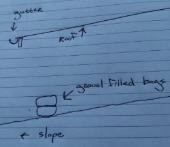Dale Hodgins wrote:This is something I gleaned from one of my posts in green building ------------------ POWER SCREENER------------I've invented a dead simple power screener. I'm sure this has been invented before but it worked so well I'm going to tell you about it anyway.----------- I needed to screen rocks out of some reasonably dry dirt. I had a big screen about 4 ft. in all dimensions. I found that it worked reasonably well when used on a slope with only gravity powering it but I wanted to make it process material quickly and to break up lumps.
I mounted an electric drill to the top of the screen. I used duct tape to attach a bolt to the side of a drill bit so that it was seriously out of balance. With the trigger locked in the "on" position, the drill vibrated wildly and transferred that energy to the screen.
No doubt this is hard on electrical equipment. But there are plenty of old drills and skill saws which have no value. Any of these items may be altered so that they shake a great deal. They could be used for processing earthen plasters, for soil sifting, etc.
We gotta do a project together sometime, Dale. You have a machine for everything.
There are two options for washing gravel that come to mind for me, for non-powered sites especially.
The first is the way a creek bed washes gravel into bars naturally. It does seem to take a lot of water flow. If you want to set up a passive landscape that can do this gradually over years, I've read about discreet gold-mining sluices that were simply made with bars of rock or timber across an existing stream. The water washes the lighter particles away over time, but heavy gold or gravel stays behind. If you don't want to pump water, you can use an existing water element like a roofline or gutterspout; I've noticed that roof driplines often expose gravel by washing away the dirt. To collect the dirt as well, set up a settling pond or pit somewhere downhill.
The second is a method I learned at Cob Cottage Co, which is more portable and works well on sites without power or running water.
Set up a screen at a sharp angle (leaning against a sawhorse e.g.), facing the source of dirt, or downhill if possible. Put a tarp behind/under the screen to collect fines, and one in front to collect gravel. Shovel the pile at the screen, one shovel-ful at a time. All the material should either go through in the instant it lands from being tossed, or shortly thereafter as it slides down the screen. Large stuff bounces or rolls easily off the front. If you get a lot of dirt in with the gravel in front, the angle may be too steep, or your pile is 'full'. I just keep shoveling until the pile underneath reaches the height of the screen; then I have to tip the screen forward and collect the piles, or move the screen to a clear space. It is not necessary to be super-picky about forcing particles through the screen; choose a larger screen size like 1/2 inch, and you will get mostly 1/4"-minus in the sifted stuff, and some of the small stuff in with your gravel but not much.
If it is necessary to break up chunks of clay, they can be soaked in water until soggy. Silty or sandy soils will generally loosen up nicely when dry. Tilling, or harrowing (dragging chains or driving over the material when it is in loose, plowed chunks) will help separate clods in larger quantities.
I suppose you could mechanize it somehow. A rock yard would drop crushed material from a conveyor or something, onto a long tilted screen (or moving screen-belt) raised high enough to allow for a large piles below, with a series of screen sizes to separate different products.
If you don't have a conveyor, you could use those corrugated panels you were excited about to make a slide or chute. I'm imagining a corrugated slope you slowly dump dirt onto from a tractor-bucket uphill, maybe with some bars or teeth to stop big chunks. The pile slides down into a rolling stream of dirt, that is directed toward the tilted screen on the downhill side.
Even a simple process of piling dirt into piles seems to concentrate the big rocks around the edges where they roll off, leaving dirt and little rocks at the top. Anything that gets it moving could work.
Whenever I try separating rocks from the garden, Ernie reminds me that the plants don't care - in fact, they like it fine with their roots in the gravel. But I like the separated gravel for drainage, and the plants don't seem to mind the rock-free soil particularly.
-Erica























 Thanks!
Thanks!
























